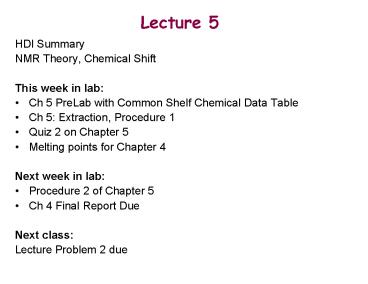HDI Summary PowerPoint PPT Presentation
1 / 16
Title: HDI Summary
1
Lecture 5
- HDI Summary
- NMR Theory, Chemical Shift
- This week in lab
- Ch 5 PreLab with Common Shelf Chemical Data Table
- Ch 5 Extraction, Procedure 1
- Quiz 2 on Chapter 5
- Melting points for Chapter 4
- Next week in lab
- Procedure 2 of Chapter 5
- Ch 4 Final Report Due
- Next class
- Lecture Problem 2 due
2
HDI Some Possibilities
- HDI 1
- One double bond
- One ring
- HDI 2
- One triple bond
- One double bond, one ring
- HDI 3
- One triple bond, one ring
- One triple bond, one double bond
- Two double bonds, one ring
- Three rings
- HDI 4 HDI 5
- Four double bonds Probably have a phenyl ring
- Two triple bonds
- One triple bond, two double bonds
- Phenyl ring
Each p bond has an HDI of 1. Each ring has an HDI
of 1.
3
1H NMR Spectrum of Ethanol
CH3CH2OH
TMS
Three signals - three different types of Hs
ppm
4
Nuclear Magnetic Resonance
- Use To assist in the elucidation of a molecules
structure - Information Gained
- Different chemical environments of nuclei being
analyzed (1H nuclei) chemical shift - The number of nuclei with different chemical
environments number of signals in spectrum - Determine the number of protons that are adjacent
to one another splitting patterns - The numbers of protons with the same chemical
environment integration - Determine how many protons are bonded to the same
carbon integration - Determine which protons are adjacent to one
another coupling constants
5
How does NMR work?
- Basic Idea
- In the presence of an applied magnetic field (Bo)
- the NMR instrument - Irridate the sample with radiofrequency
radiation - 2. Nuclei resonance excite magnetic transitions
- 3. Measure the energy absorbed/released by nuclei
- 4. Obtain a spectrum
6
An NMR Diagram On the Inside
N
7
How does NMR work?
- Facts that allow NMR to work
- Nuclei have a spin (like electrons).
- Nuclei that have odd mass or odd atomic number
have a quantized spin - angular momentum and a magnetic moment.
- The allowed spin states a nucleus can adopt is
quantized and is determined - by its nuclear spin quantum number, I.
- 1H and 13C nuclei have I 1/2.
- Thus, there are two allowed spin states 1/2 and
-1/2.
8
1H NMR Spectroscopy
- 1H nuclei have magnetic spin, I 1/2.
- The nuclei can either align with (1/2) or oppose
(-1/2) the applied magnetic field, Bo (from the
NMR instrument). - When the nuclei absorb the radiofrequency pulse
(a specific energy is absorbed since the spin
states are quantized!), the spin flips -
resonance. - When the pulse is over, the spin relaxes back to
its original state. - The spin releases the energy that it had
originally absorbed - this is the energy that is
measured. - This happens to each 1H nuclei in the sample, but
not every 1H nuclei are the same.
9
How does NMR work?
Without magnetic field
In magnetic field, Bo
10
How does NMR work?
Higher energy state magnetic field opposes
applied field
Nuclei are charged and if they have spin, they
are magnetic
Applied Magnetic Field Bo
Energy of transition energy of radiowaves
Lower energy state magnetic field aligned with
applied field
11
Getting a Spectrum
- Pulse sample with radiofrequency radiation, spin
flip - resonance. - After pulse, the excited nuclei lose their
excitation energy and return to - their original state - relax.
- As the nuclei relax, they emit electromagnetic
radiation results in - free-induction decay (FID)
- FID contains all emitted frequencies
- Fourier transform (FT) is performed on the FID.
- FT extracts the individual frequencies on the
different nuclei results in - a spectrum.
12
An NMR Diagram On the Inside
N
13
Chemical Shifts
- Not all proton nuclei resonate at the same
frequency. - Proton nuclei are surrounded by electrons in
slightly different chemical environments - nuclei
are shielded by valance electrons that surround
them. - As a result, the nuclei are shielded from Bo to
an extent that depends on the electron density
around it. - A shielded nucleus will feel a diminished Bo and
will absorb radiofrequency radiation at a lower
frequency - have a lower ppm value. - A deshielded nucleus will feel a stronger Bo and
will absorb radiofrequency radiation at a higher
frequency - have a higher ppm value. - Different nuclei will be shielded differently
and, as a result, will have different - resonance frequency - different ppm values -
different chemical shifts.
14
The NMR Spectrum
15
Chemical Shifts
- Protons near an electronegative group will be
deshielded - feel a stronger Bo - have a higher
ppm value. - Electronegative groups OH, OR, Cl, F, Br, N
- Other deshielding groups CC, phenyl, CO
16
1H NMR Spectrum of Ethanol
c
a
b
a
CH3CH2OH
TMS
Three signals - three different types of Hs
b
c
ppm

